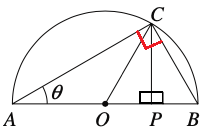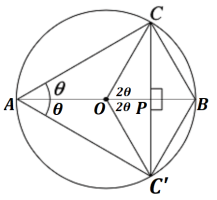You are using an out of date browser. It may not display this or other websites correctly.
You should upgrade or use an alternative browser.
You should upgrade or use an alternative browser.
Semicircle Right Angled Trig: In the diagram, O is the centre of semicircle ACB, and...
- Thread starter duccaroni
- Start date
- Joined
- Feb 4, 2004
- Messages
- 16,550
What are your thoughts? What have you tried? How far have you gotten? ("Read Before Posting")
Please be complete. Thank you!
Dr.Peterson
Elite Member
- Joined
- Nov 12, 2017
- Messages
- 16,861
Hint for (a): What other angle(s) can you label, using only theorems you know? There are a couple theorems about angles in triangles that will be useful.
Hint for (b): Write a couple expressions each for [imath]\sin\theta[/imath] and for [imath]\cos\theta[/imath].
Hint for all parts: Think. You won't solve the problem with no effort of your own. Once you've thought, and shown your thoughts, we can help you use those thoughts.
The Highlander
Senior Member
- Joined
- Feb 18, 2022
- Messages
- 1,195
There are certain bits of basic knowledge (about Circle Theorems and Trigonometric Identities) that I would expect you might have been taught before you were set this type of question.
If you don't know at least some of these already then I'm unsure as to how you are supposed to go about answering the question but if you have been taught these then perhaps some gentle reminders that I provide here will allow you to proceed.
Firstly, Circle Theorems:-
Clearly, since ∠BPC = 90° then ∠OPC = 90° too, just as I have marked on the modified diagram below.
But ∠ACB is also 90° (as I have marked in red).
Why? See what I have highlighted for you on this website (qv).
You should also watch the video immediately following the text for the proof of this and commit this fact to memory; you will definitely need it again in future.
Now consider the complete circle that would correspond to your diagram (as I have shown below) and read what I have highlighted for you on this website (qv).
From what you (should have) learned there:-
∠CAC' = 2θ ⇒ ∠COC' = 4θ ⇒ ∠COP = ?? (∠COP & ∠POC being exactly the same angle of course.)
Again, you should watch the video that follows immediately after the text for the proof of the theorem and, again, retain this fact for future use.
Part a:-
The first part (that ∠POC = 2θ) is a direct result of the 2nd Circle Theorem (above) so no "proof" is necessary, you can just state it as "the angle at the centre is twice the angle at the circumference", though a diagram (like my 2nd one) would help to illustrate what you mean by that in this case.
In the second part (that ∠PCB = θ), now that you have shown that ΔACP and ΔABC are both right-angled triangles, it is clear from ΔACP that ∠ACP = (90 - θ)° and, since ∠ACB = 90°, then ∠PCB is the complement of ∠ACP so ∠PCB = θ.
Alternatively, you could say that, from ΔABC, ∠ABC = (90 - θ)° and, because ΔPBC is right-angled too, then, since ∠PBC = (90 - θ)°, ∠PCB must be θ.
Part b:-
Remembering your basic right-angled triangle trigonometry (SOH CAH TOA), you have now shown that ΔAPC and ΔABC are both right-angled triangles so you can use those definitions to determine that...
from ΔAPC, sin θ = \(\displaystyle \frac{PC}{AC}\)
and
from ΔABC, cos θ = \(\displaystyle \frac{AC}{AB}\)
and
from ΔABC, cos θ = \(\displaystyle \frac{AC}{AB}\)
So, sin θ cos θ \(\displaystyle = \frac{??}{??} \times \frac{??}{??} = \frac{??}{??}\)
Part c:-
"sin 2θ = 2 sin θ cos θ" is actually a well-known Trig Identity but it derives from the basic double angle formula that: sin (A + B) = sin A cos B + cos A sin B (which trust you are already familiar with?)
Thence, if A & B are the same angle (B = A), you get...
sin (A + A) = sin 2A = sin A cos A + cos A sin A = sin A cos A + sin A cos A = 2 sin A cos A.
(Substitute θ for A and "Bob's your uncle!"
Alternatively, if you are meant to arrive at the stated result by using the fact that sin θ cos θ \(\displaystyle = \frac{PC}{AB}\)
(as demonstrated in Part b) then you could use the fact that ΔPOC is yet another right-angled triangle, where you have already established (in Part a) that ∠POC = 2θ to show that sin 2θ \(\displaystyle = \frac{PC}{OC}\) and, of course, OC = ½AB.
But I will leave you to figure out the rest of that method if that's the way you need to go (if you haven't been taught any of the basic Trigonometric Identities yet).
Please now come back and show us your full workings to get the answers required (feel free to use my diagrams, if you wish, to illustrate your work).
NB: You can just write your work out on paper (in pencil or ink) and submit a picture or pictures of it but please make everything clear and legible. (There are lots of old eyes in here and few of us have the time or enthusiasm to decipher writing or working that is hard to read!
Hope that helps.
Last edited:




